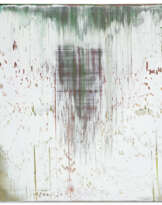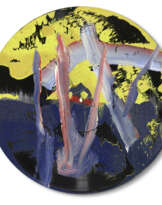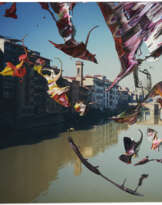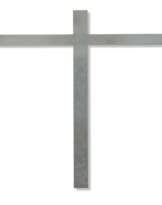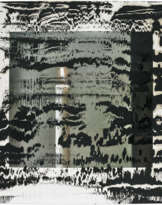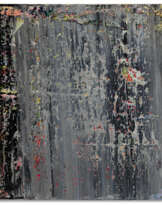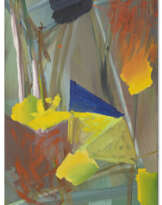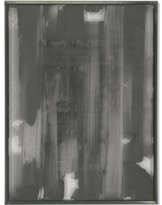ID 1066889
Lot 92 | Gerhard Richter (1932 Dresden) (F)
Estimate value
€ 28 000 – 90 000
Gerhard Richter (1932 Dresden) (F)
'7.5.82', Lack auf Karton, 11,3 cm x 16 cm Objektmaß, verso signiert, 7.5.82 datiert, montiert. Zu dieser Arbeit liegt ein Zertifikat von Herrn Dr. Dietmar Elger, Gerhard Richter Archiv Dresden, datiert auf den 2.10.2023, im Original vor. Es hat die Zertifikatsnummer GRA/1251. Das Gemälde ist im Gerhard Richter Archiv verzeichnet. Wir danken Herrn Dr. Dietmar Elger für die freundliche Unterstützung.
"Ich verfolge keine Absichten, kein System, keine Richtung, ich habe kein Programm, keinen Stil, kein Anliegen." Mit diesen Worten beschreibt sich der wohl bekannteste, erfolgreichste und vielseitigste zeitgenössische Künstler selbst - Gerhard Richter.
Diese scheinbare Ziellosigkeit spiegelt sich auch in dem bei uns angebotenen abstrakten Werk wider, welches auf den 7.5.82 datiert ist. Damit stammt unsere Arbeit aus der bedeutendsten Schaffensperiode Richters - den 1980er Jahren - welche bis heute wegweisend für seine abstrakte Malerei ist. In den 1960er Jahren erlange Gerhard Richter mit seinen verwischten, fotorealistischen Gemälden weltweit Bekanntheit. Seit den 1970er Jahren finden sich verstärkt abstrakte Werke in seinem facettenreichen Oeuvre. Seinen Wechsel zur Abstraktion erklärt Richter in einem Gespräch mit Nicolas Serota, im Rahmen der Ausstellung "Gerhard Richter - Panorama" in der Tate Gallery in London 2011. Serota fragte, weshalb Richter sich, trotz seines enormen Erfolges als gegenständlicher Maler, der Abstraktion zuwandte. Der Künstler erwiderte: "Vielleicht weil ich ein unsicherer Typ bin, etwas unstet. Das Abstrakte hat mich immer schon fasziniert. Es hat so viel Geheimnis, so wie Neuland" (Gerhard Richter, in: Panorama, 2012, S. 21). Für ihn ist die abstrakte Malerei nicht nur eine stete Herausforderung, sondern eine Form, in der sich Vieles zeitgleich ausdrücken lasse, "meine Gegenwart, meine Wirklichkeit, meine Probleme, meine Schwierigkeiten und Widersprüche" (Dorothea Detrich und Gerhard Richter, in: Gerhard Richter: An Interview, Print Collector's Newsletter, 16, 1985, S. 128). Ein Element, welches das vielschichtige Oeuvre Gerhard Richters immer wieder verbindet, und sich wie ein roter Faden durch sein Schaffen zieht, ist die vermeintlich simple und doch so komplexe Frage "Was ist Malerei?". Mit jedem Werk hinterfragt der Künstler die Natur der Malerei immer wieder aufs Neue und analysiert sein eigenes Medium kontinuierlich. Insbesondere in seinen abstrakten Werken, welche zu den gefragtesten Arbeiten auf dem internationalen Auktionsmarkt gehören, überlässt er durch die Verwendung von Werkzeugen, wie Spatel, Spachtel oder Rakel, das Ergebnis weitgehend dem Zufall. Seine abstrakten Werke stellen eben nicht die persönliche Handschrift Richters in den Fokus, sondern den Zufall, die Überlagerung von Farben und vor allem die Eigenwirkung des Materials. Vollendet sind diese abstrakten Arbeiten "[.] wenn ich nichts mehr daran tun kann, wenn es mich übertrifft, also etwas hat, wo ich nicht mehr so ganz mitkomme." (Gerhard Richter, in: Peter Sager, Mit der Farbe denken: G. R., Zeitmagazin, 49, 1986). Auf dem hier angebotenen Werk trägt Gerhard Richter auf kleinem Format, unterschiedliche Schichten von Lack übereinander auf den leichten Karton auf. Durch die Überlagerung von gelben, roten, grauen und weißen Farbschichten entsteht ein illusionistischer Bildraum mit einer intensiven Wirkung. Auf gerade einmal 11,3 x 16 cm lässt Gerhard Richter ein flächiges Werk entstehen, das durch seine Farbigkeit besticht und gleichzeitig eine spannende Räumlichkeit suggeriert. Dieses Spiel der changierenden Farben, zwischen Flächigkeit und Dreidimensionalität macht das Kunstwerk zu einer einmaligen Farbraummodulation und bietet einen regelrechten Sehgenuss für den Betrachter. Gerhard Richter gelingt es auch hier, eine neue Form der abstrakten Malerei zu schaffen, die eine eigenständige visuelle Erfahrung ermöglicht und die Grenzen des Mediums Malerei aufs Neue auslotet.
Gerhard Richter (1932 Dresden) (F)
'7.5.82', lacquer on cardboard, 11,3 cm x 16 cm object dimensions, signed on verso, dated 7.5.82, mounted, a certificate from Dr. Dietmar Elger, Gerhard Richter Archiv Dresden, dated 2.10.2023, is available for this work in the original. It has the certificate number GRA/1251. The painting is listed in the Gerhard Richter Archive. We thank Dr Dietmar Elger for his kind support.
''I pursue no intentions, no system, no direction, I have no programme, no style, no concern.'' With these words, probably the most famous, successful and versatile contemporary artist describes himself - Gerhard Richter.
This apparent aimlessness is also reflected in the abstract work offered by us, which is dated 7.5.82. Thus our work comes from Richter's most important creative period - the 1980s - which is still groundbreaking for his abstract painting today. In the 1960s, Gerhard Richter achieved worldwide fame with his blurred, photorealistic paintings. Since the 1970s, his multifaceted oeuvre has increasingly included abstract works. Richter explains his shift to abstraction in a conversation with Nicolas Serota, in the context of the exhibition ''Gerhard Richter - Panorama'' at the Tate Gallery in London in 2011. Serota asked why Richter, despite his enormous success as a representational painter, turned to abstraction. The artist replied: ''Maybe because I'm an insecure type, a bit erratic. The abstract has always fascinated me. It has so much mystery, like new territory'' (Gerhard Richter, in: Panorama, 2012, p. 21). For him, abstract painting is not only a constant challenge, but a form in which many things can be expressed simultaneously, ''my present, my reality, my problems, my difficulties and contradictions'' (Dorothea Detrich and Gerhard Richter, in: Gerhard Richter: An Interview, Print Collector's Newsletter, 16, 1985, p. 128). One element that repeatedly connects Gerhard Richter's multi-layered oeuvre and runs like a thread through his work is the supposedly simple and yet so complex question ''What is painting?''. With each work, the artist questions the nature of painting again and again and continuously analyses his own medium. Especially in his abstract works, which are among the most sought-after works on the international auction market, he leaves the result largely to chance by using tools such as spatulas, palette knives or squeegees. His abstract works do not focus on Richter's personal handwriting, but on chance, the overlapping of colours and, above all, the intrinsic effect of the material. These abstract works are completed ''[...] when I can do nothing more to it, when it surpasses me, i.e. has something where I can no longer quite keep up.'' (Gerhard Richter, in: Peter Sager, Mit der Farbe denken: G. R., Zeitmagazin, 49, 1986). In the work offered here, Gerhard Richter applies different layers of varnish on top of each other to the light cardboard in a small format. The superimposition of yellow, red, grey and white layers of paint creates an illusionistic pictorial space with an intense effect. On just 11.3 x 16 cm, Gerhard Richter creates a two-dimensional work that captivates with its colourfulness and at the same time suggests an exciting spatiality. This play of changing colours, between two-dimensionality and three-dimensionality, makes the work of art a unique modulation of colour space and offers the viewer a real visual pleasure. Here, too, Gerhard Richter succeeds in creating a new form of abstract painting that enables an independent visual experience and explores the boundaries of the medium of painting anew.
| Artist: | Gerhard Richter (1932) |
|---|---|
| Auction house category: | Painting of the 19th and 20th century |
| Artist: | Gerhard Richter (1932) |
|---|---|
| Auction house category: | Painting of the 19th and 20th century |
| Address of auction |
WETTMANN | Auktionshaus an der Ruhr Friedrichstraße 67-67a 45468 Mülheim an der Ruhr Germany | ||||||||||||||
|---|---|---|---|---|---|---|---|---|---|---|---|---|---|---|---|
| Preview |
| ||||||||||||||
| Phone | +49 (0)208 3059081 | ||||||||||||||
| Fax | +49 (0)208 4391735 | ||||||||||||||
| Buyer Premium | 30% | ||||||||||||||
| Conditions of purchase | Conditions of purchase | ||||||||||||||
| Business hours | Business hours
|





